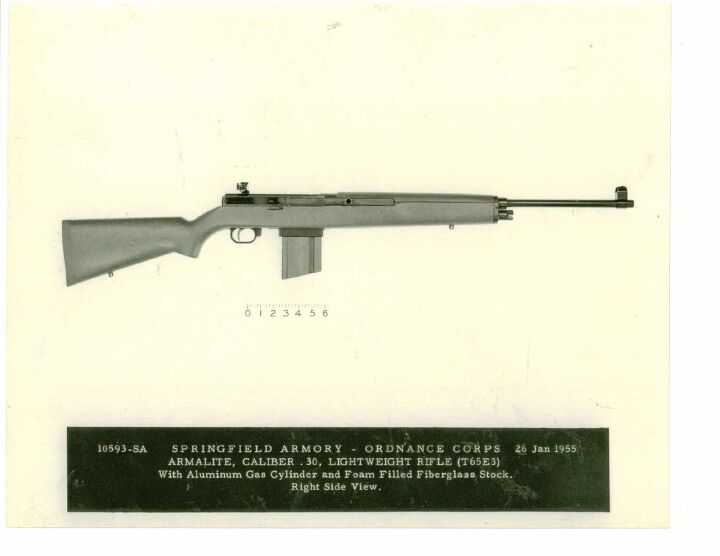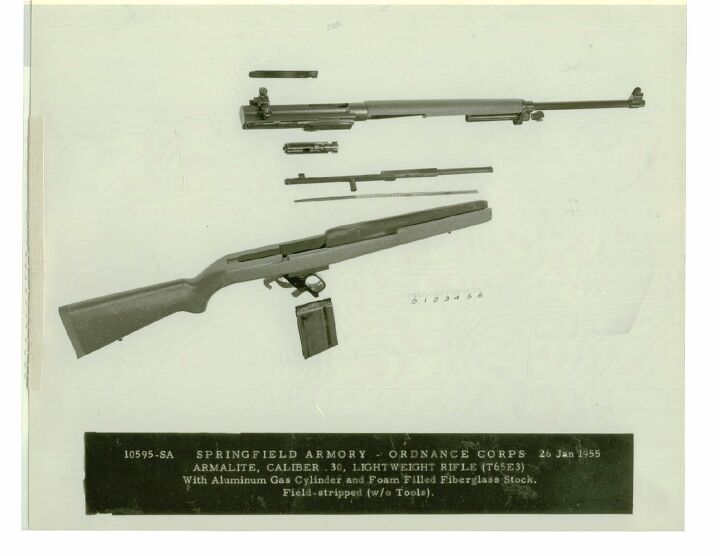10. Thorneycroft Carbine
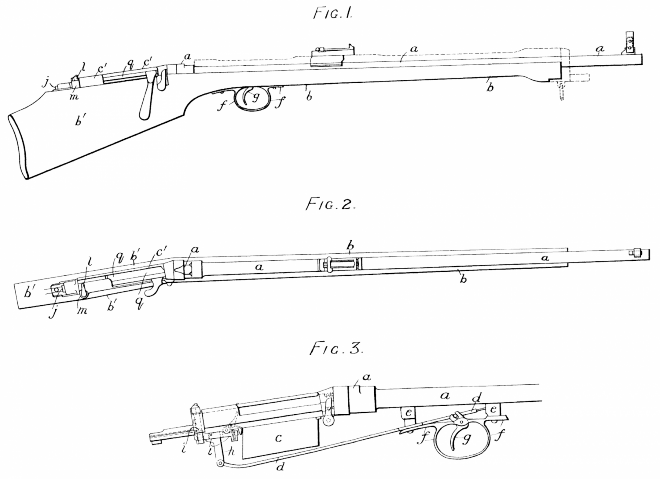
An image from the Thorneycroft rifle patent. One can see the trigger linkage, as well as the unique double-angle inclined action. Image source: wikipedia.org.
Some of you might be familiar with this gun, but few know that almost all available pictures of it are misleading, at best. The picture below is not of the original Thorneycroft Carbine, but of the later Thorneycroft-Farquhar rifle.

The Thorneycroft-Farquhar rifle. An improved design, lacking the inclined action of the original. Developed in 1905, it was quickly overshadowed by the SMLE. Image source: militaryimages.net.
The title image is of the original patent, but the image below is an actual photograph of the carbine tested by the British in the years after 1901.

The Thorneycroft Carbine, proper. Its inclined action is evident, as is the fact that left-handed shooters would have some ergonomic problems when using it. This would later be echoed in another British bullpup, the SA80/L85, which was adopted and remains the standard British infantry weapon. Image source: militaryimages.net.
The Thorneycroft helps illustrate the long history Britain has with bullpup designs. As far as can be determined, the Thorneycroft is the first bullpup rifle design to undergo anything like an extensive trial run. Whether the bullpup layout’s advantages outweigh its disadvantages is still a matter of debate, but the concept has steadily grown in popularity in the 20th Century. Today it sees its greatest level of success yet, with multiple bullpup designs issued as standard arms in numerous countries (Israel, Austria, and France to name just three). The conventional layout rifle continues to make up the majority of standard weapon designs, but it’s clear that the bullpup rifle concept is one to pay close attention to in the coming years.
9. The Armalite AR-1
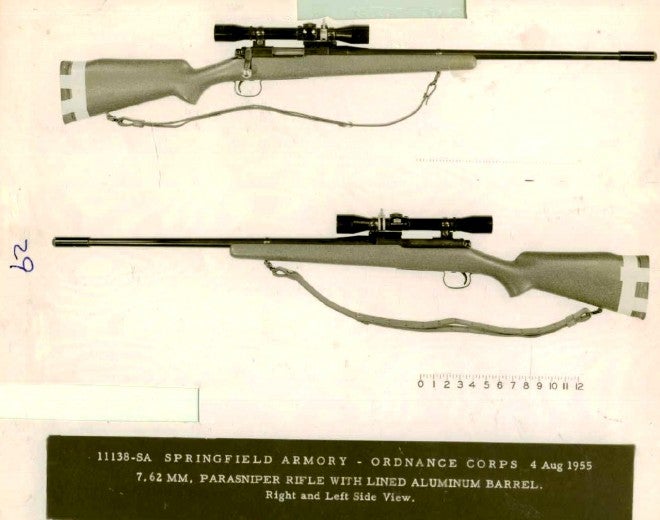
Ordnance picture of the Remington 722-based AR-1. Note the short, low profile bolt shroud, as well as the lack of a takedown lever on the left side, identifying this as a Remington 722 action. Image source: ar15.com.
Armalite’s “AR” numbers, ending in “AR-18” are sequential corporate designations. The famous AR-15 and AR-10 were the fifteenth and tenth designs, respectively. What was the first? That would be the AR-1 “Parasniper” of 1952, a .308 caliber bolt action rifle, originally based on a Remington 722 action, but later based on an FN Mauser action. It was optimized for light weight, and utilized a steel-lined aluminum barrel of a similar type eventually used on the AR-10 (which famously burst in US military trials), and a foam-filled fiberglass stock. The rifle also sported a compensator for recoil reduction. With all of these features, it weighed in at a then-scant six pounds fully loaded with scope and sling.
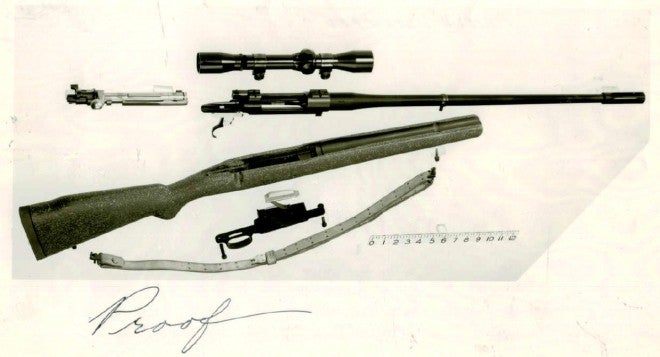
The Mauser-based AR-1. Notice the wing-style safety, as well as the large extractor on the bolt, identifying this as an FN Mauser action. Image source: ar15.com.
The AR-1 was at one point taken on an African safari, participating in which were Richard Boutelle (President of Fairchild, Armalite’s parent company) and General Curtis LeMay of the US Air Force (which would later be the first to adopt Armalite’s .223 caliber AR-15 rifle).
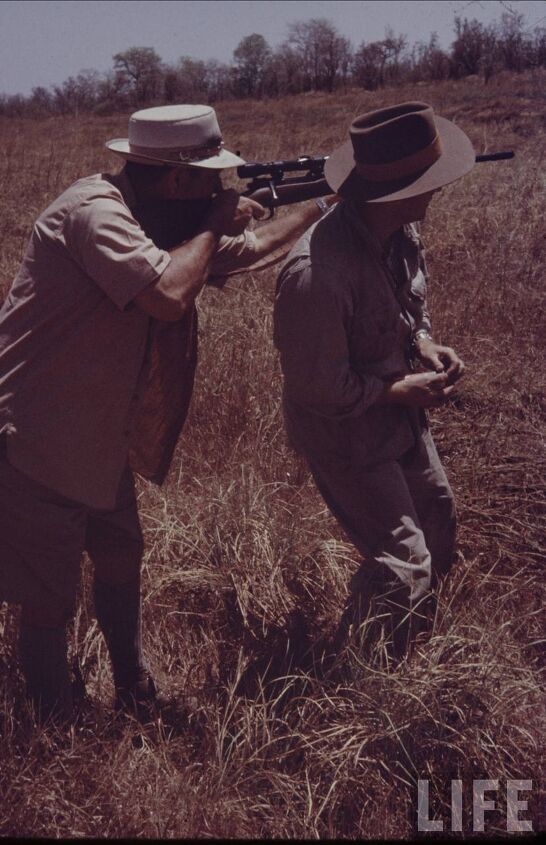
Richard Boutelle on an African safari, holding a Mauser-based AR-1 rifle. The character on the right, against whom Boutelle appears to be bracing the lightweight rifle, is most likely General LeMay.
8. The TKB-517

The TKB-517 in profile. Its inexpensive stamped and riveted construction is evident, as is the greater sophistication of the stampings vs. earlier designs. This rifle out-shot and out-bid the Kalashnikov, but was considered riskier in the long run.
In the late 1950s, the Red Army was looking to modernize her arsenal of small arms by creating a lightweight, easily mass produced automatic carbine that could be issued in lieu of existing SKS and AK carbines, PPSh and PPS sub-machine guns, and RPD squad automatic weapons. The weapons that eventually resulted were the AKM carbine and RPK automatic rifle, but one very promising competitor to the Kalashnikov design was a lever-retarded (Kiraly) blowback rifle designed by one Gherman A. Korobov. Cheaper to make, lighter, and more accurate in full auto than the AKM, the TKB-517 was arguably the superior weapon. Later, the French FAMAS bullpup would resurrect Paul Kiraly’s lever-retarded blowback mechanism.
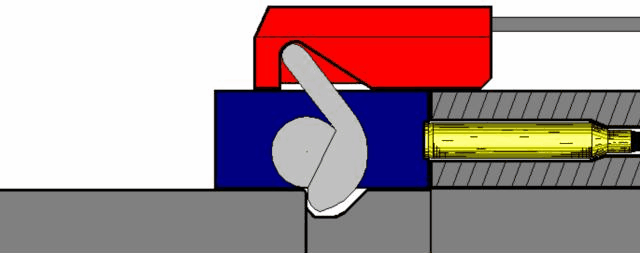
A simplified diagram of the lever-delayed blowback mechanism that was the heart of the TKB-517 rifle. Image source: firearmshistory.blogspot.com.
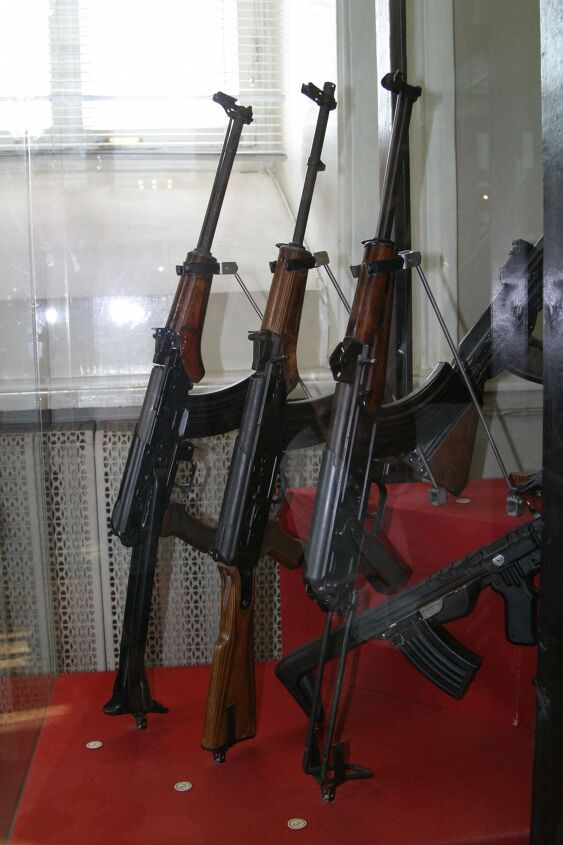
Three TKB-517 rifles. This image offers a considerably greater level of detail than previous images available in the West; visible are three different stock configurations (folding, fixed, and collapsible a la the US M3 sub-machine gun. Further evident are two different kinds of rear sight, three different kinds of front sight block, and at least two patterns of receiver. Also note the TKB-517’s forward-mounted charging handle, a position that would return to Russian small arms design with the AK-12 rifle.
Korobov was an engineer at the distinguished firearms maker Tula, where he designed numerous other inventive and radical weapons, including the extremely early bullpup TKB-408, and the bizarre TKB-022.
7. URZ Weapons System
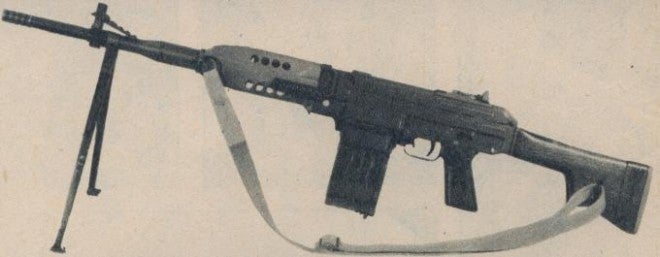
The URZ in squad support configuration. The belt-in-box magazine system was common to every variant of the family. Image source: valka.cz.
The “family of weapons” concept pioneered by the French and bushwhacked by the Stoner 63 family was taken to extremes by Jiri Cermak in the late 1960s, who also designed the world-class Vz. 58 rifle. The weapons family – as it truly was that – was called URZ and represented an attempt to replace everything from the sub-machine gun up to the fixed emplacement machine gun.
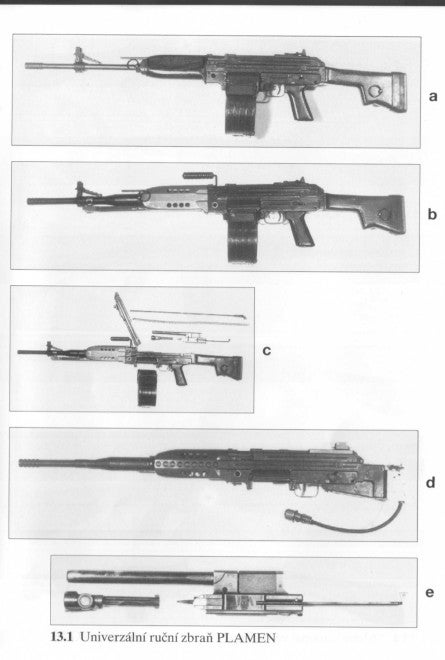
The URZ family: a. Rifle configuration, b. Squad support, c. Squad support, field stripped, d. Electrically triggered armored vehicle variant, e. Retarded-blowback operating group. Image source: uchytil.info.
This was accomplished by a common receiver, which in all models was belt-fed from a cylindrical container. Most strangely for a Warsaw Pact country, the weapons system was chambered for then-new 7.62×51 NATO caliber, as it was intended for export. While the URZ is now obscure, its patents are available online, showing the design of the rotary roller-retarded blowback mechanism, as well as its belt-in-box feed system and its trigger mechanism.
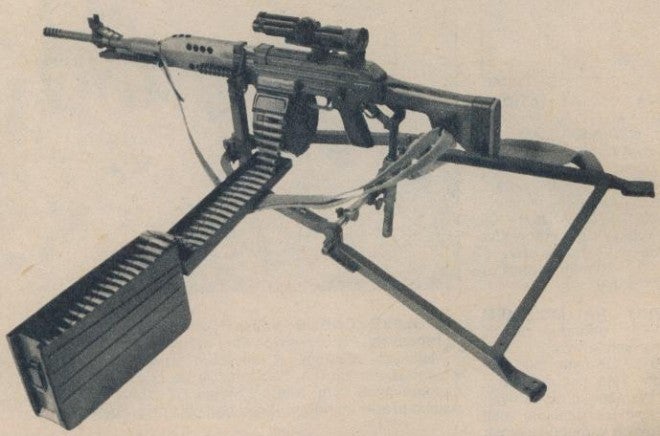
The URZ squad support variant in a GPMG configuration, mounted on a tripod, with optic. Image source: valka.cz.
6. DISA Karabin

The 7×36 DISA Karabin. Chambered for a shortened, necked-down wildcat of .30-06, this rifle has alternately been called the “Madsen” and “Otterup” carbine. Image source: Unknown, taken from author’s photo collection.
Like other experimental Danish small arms, very little information is available in English regarding this rifle. What is known is that it was developed in the 1960s in Denmark by Dansk Industri Syndikat A/S (DISA), formerly Compagnie Madsen A/S. It was chambered for a short 7mm round formed by cutting down .30-06 cases.
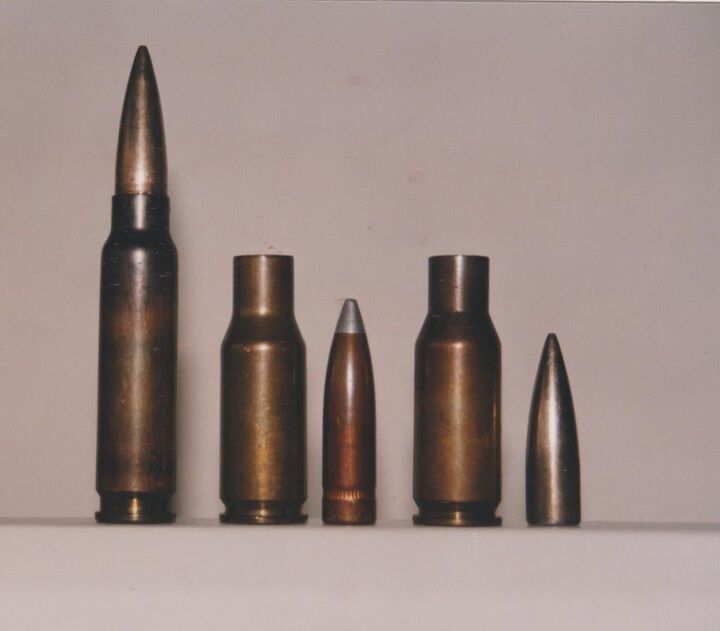
7×44 Weibel, next to two 7×36 DISA/Otterup/Madsen cases and projectiles. The 7x44mm cartridge was an earlier Danish 7mm development from before World War II. Image source: iaaforum.org.
5. T28 Light Rifle

Late version of the T28 rifle. The Army by this point had taken notice of in-line stock design, and both the T25 and T28 rifles were made with in-line wooden stocks. Eventually, though, conservatism won the day and neither the T28 nor the T25 saw service, nor would the in-line stock concept be put into practice until the adoption of the “not invented here” AR-15. Image source: forgottenweapons.com.
The American Light Rifle program of the late 1940s and early-mid 1950s was a storied one. In trying to “have it all”, the Americans were eventually left in the early 1960s with one of the bulkiest, heaviest, and most primitive designs of any nation, despite protracted research and development. Along the way, however, US small arms designers created some fascinating weapons, one of which was the T28 rifle, a direct evolution of German small arms design of the Second World War. Forgotten Weapons has more information on this rifle, but the weapon was a close adaptation of the German Gerat 03, a roller locked, short-stroke piston operated weapon using stamped components, by an engineer named Cyril Moore. This was one of the earliest self-loading weapons to use the .30 T65 rifle cartridge, which at that point was just an unmodified .300 Savage case loaded with the 152gr bullet of the M2 .30-06 round. The T28 would lose out to the T25, itself a very sophisticated rifle based on a European design (in its case Polish), but the T65 rifle cartridge would eventually be developed into first the .308 Winchester sporting cartridge, and then the 7.62x51mm NATO round.
4. AR-3/M7 Rifle
The second Armalite firearm on the list, the AR-3, also designated “M7” was based on Eugene Stoner’s earlier M5 and M6 hunting rifle designs.
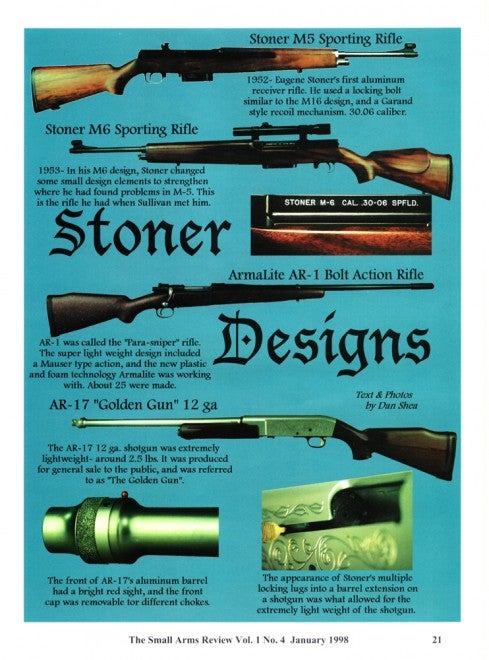
The wood stocked M5 and M6 are shown in this page from Small Arms Review, of January 1998. Both were chambered in .30-06, and featured steel receivers. Image source: ar15.com
While the M5 and M6 both had wooden stocks and steel receivers, the M7 was the first Stoner design to feature the Armalite trademark: Aluminum construction. Further, the M7 had a lightweight foam-filled fiberglass stock, military sights, and was chambered for the experimental .30 Lightweight Rifle T65E3 cartridge (which eventually became the 7.62 NATO), suggesting it was intended as a military – rather than sporting – arm. At some point it was cataloged by Springfield Armory, though whether it was evaluated or tested in any way is unknown to the author.
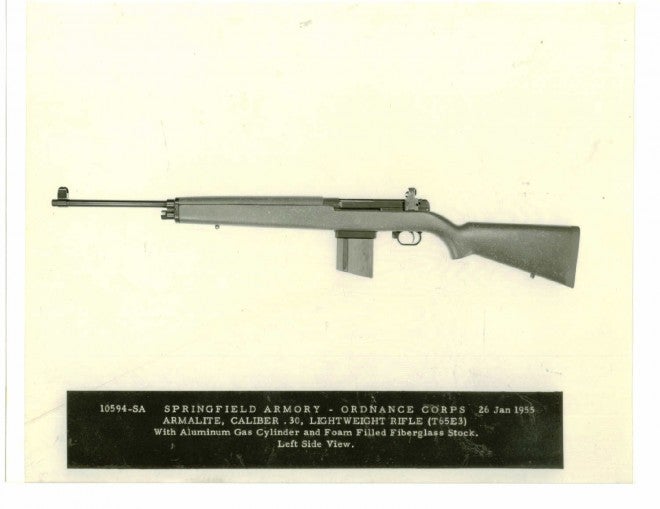
The AR-3, originally called the M7 by its designer, Eugene Stoner. Note the fiberglass stock, shorter magazine, and winged military front sight, in contrast with its predecessors. Image source: ar15.com.
The M7/AR-3 used a Garand-style long-stroke gas piston, coupled to the familiar Stoner-Johnson seven lugged rotary bolt via a Lewis-style cam on the operating rod, acting on a cam track machined into the bolt. While no clear pictures of the trigger mechanism are available, it does appear to be similar to the Garand in the shape of the hammer.
Stoner’s next design, the M8, would use his direct impingement gas system invention, and would lead directly to both the moderately successful AR-10, and extremely successful AR-15 designs.
3. Sudaev AS-44
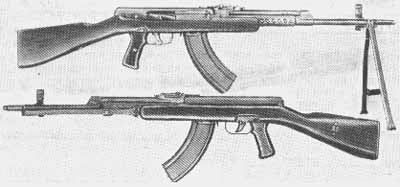
One of the variations of the Sudaev assault rifle, AS-44, with bipod. Image source: armchairgeneral.com
One of the most interesting forgotten rifles of World War II, the Sudaev AS-44 was a limited production assault rifle that saw service in 1945 in troop trials just after the victory in Europe. The AS-44 was chambered for the new 7.62x41mm cartridge – the predecessor to the highly successful 7.62x39mm Soviet intermediate cartridge, which arose as a modification to allow the design to use steel-cored projectiles. Like the MP.44, Ribeyrolle CM 1918, and many other early assault rifle designs, the AS-44 was heavy, at around 11 pounds unloaded.
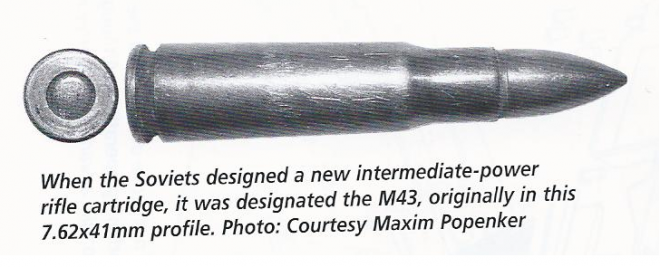
The 7.62x41mm Soviet intermediate power cartridge of World War II. This was the round used in early SKS rifles, and the Sudaev assault rifle. It used a lead-cored bullet and was replaced by the 7.62x39mm cartridge, which was modified to use longer-ogive steel-cored projectiles. Image source: The World’s Assault Rifles, by Gary Paul Johnston.
The AS-44 used the highly successful tilt-locking bolt pioneered by the Czechs in the ZB 26 machine gun, and also used in the MP.44, coupled – also like the MP.44 – to a fixed piston similar to that later used in the AK rifle.

A later Sudaev rifle with a two-piece stock> Note the tilting bolt and fixed piston, a similar mechanism – though different in form – to that used in the MP.44. Image source: imgur.com.
Sudaev’s rifle was promising, but by 1945 Sudaev himself had fallen severely ill, and he died the next year. While development of his rifle ceased, elements were carried forward in the Kalashnikov assault rifle design, which became the world-famous AK rifle.
2. MAS 38
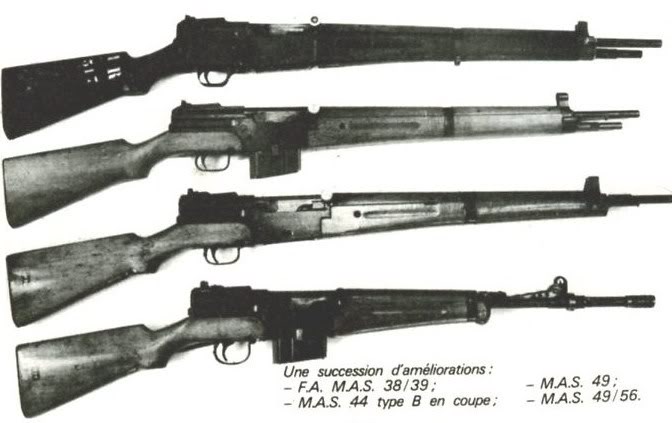
The MAS 38, along with its offspring, the MAS 44, MAS 49, and MAS 49/56. The autoloading MAS series of rifles are often viewed as post-war technology, but in fact their lineage dates back to before the 20th Century. Image source: surplusrifleforum.com.
Perhaps more than any other nation, the French coveted to have a standard-issue semi-automatic weapon; in a cruel twist of fate, they would not achieve that dream until the late 1940s, after many other countries had fielded selfloaders of their own. France’s romance with the autoloading rifle goes back to the 19th century and her rivalry with neighboring Germany. The French continued perfecting the autoloading rifle through World War I and after, until finally the design reached a head with the MAS 38, which was the first autoloader to pass French testing with a higher level of reliability than bolt action rifles. Here the design of the MAS was mature: Present was the durable two-piece stock, the reliable direct-gas system, the simple and inexpensive (and not easily fouled) tilting bolt. Different than its descendants, the MAS 38 used an integral box magazine fed by stripper clips, and a spike bayonet stored within the stock. French efforts to further refine the design with the MAS 40 would leave them caught at the beginning of World War II without a selfloading infantry rifle still, and development cease until after World War II.
The MAS 44, a further refinement of the MAS 40, sporting a detachable magazine (but retaining the spike bayoner) was finally adopted in 1945, just after Allied victory in Europe. Few MAS 44s were produced, but they did see combat with Marine Commandos in Indochina. The deletion of the spike bayonet, the revision of the rear sight, the addition of an integral grenade launcher (heralding the coming of the French “universal grenadier”) and a scope rail machine into the receiver of every rifle produced the MAS 49. A new grenade launcher design, provision for knife bayoner, a gas cutoff allowing the safe firing of 22mm finned rifle grenades, and a shorter forestock resulted in the MAS 49/56, which for many years was synonymous with the French infantryman.
The MAS 38 deserves a special place in history: It was here that the selfloading rifle finally came of age. No one else had more experience with autoloaders to that point than the French, and the MAS 38 was the result of this unparalleled pool of knowledge. Its successors – the MAS 49 and 49/56 – would prove in combat the great reliability of the design: Ready for action in 1938, were it not for the obsessive perfectionism of French rifle procurement.
1. Mauser 1918
The top of the receiver of the Mauser 1918. Note the integral (and very slick-looking) dust cover. Image source: forums.nitroexpress.com.
Despite the stratospheric popularity of the Mauser 98 rifle, the follow-on design, the Mauser Gewehr 1918(?) is barely known. In doing the research for this article, I was only able to find pictures of one of these rifles, but luckily it was a surviving example in good condition (though apparently sporterized).
This rifle was – and still is, really – the ultimate bolt-action rifle. Based on the 98 action, it features a number of improvements that enhance the rifle’s effectiveness, resistance to the elements, and even aesthetics.
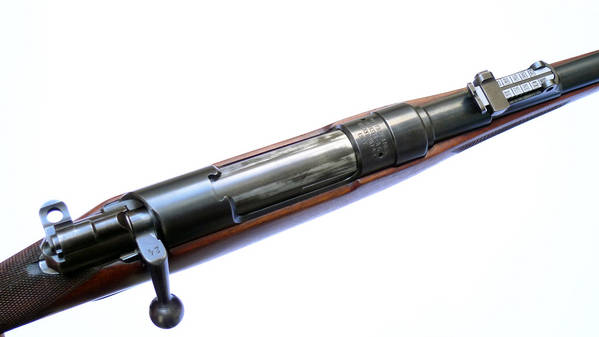
The top of the Mauser 1918 receiver. Note the integral dust cover. Image source: forums.nitroexpress.com.
These improvements included:
- An integral dust cover to protect the action from dirt and dust ingress.
- A detachable box magazine, with an ergonomic catch.
- A “slick-side” receiver lacking the characteristic Mauser disassembly lever.
- A revised and simplified bolt shroud.
What other improvements Mauser might have made are unknown to me. Very little information is available on the weapon at all, either on the Internet or in the library resources I have access to. It remains an enigmatic and thoroughly fascinating missing page from the history of the military bolt action rifle.
What rifles do you think are largely forgotten and deserve more recognition? Let use know in the comments!
 Your Privacy Choices
Your Privacy Choices
